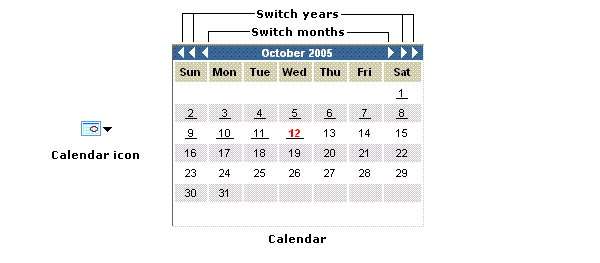The Daily Prenote Audit report lists all pre-notification ACH entries for a specific date. The system generates a pre-notification entry (prenote) when a DDA (Demand Deposit Account) number or a Transit Routing Number is added or changed.
 ACH.
ACH.The Automated Clearing House is a computer-based clearing and settlement service for the interchange of electronic debits and credits among financial institutions.
The page refreshes and Daily Prenote Audit filter criteria become available.
 calendar icon, and then select the date for which you want to view pre-notification entries.
calendar icon, and then select the date for which you want to view pre-notification entries.Some date fields in this application offer calendars that allow you to select the date to enter in the date field. When a calendar is available, the calendar icon is present. Click the calendar icon to open the calendar. In the calendar, use the outer arrows to switch between years, and the inner arrows to switch between months. Click a date to insert the date into the date field.
 _
_
Note: To select multiple bank numbers, press and hold Ctrl, and then click the bank numbers you want.
 Merchant ID number.
Merchant ID number.A number assigned by TSYS that identifies the merchant.
Note: You can search for a merchant ID number. For more information, refer to Searching for data entities.
 Key DDA, select it from the drop-down list.
Key DDA, select it from the drop-down list.This indicates whether the DDA number in the previous field was captured as keyed or edited by the system. Possible values are as follows:
If data for the selected criteria are available, the report appears.
Note: You can customize the data you want to view. For more information, refer to Customizing Reports.
The Daily Prenote Audit report includes the following data:
A row in a report that indicates one or more categories by which data in the report is grouped.
The number that identifies the bank.
A number assigned by TSYS that identifies the merchant.
The merchant DBA (Doing Business As) name.
A two-part field that identifies why a prenote was generated. The first three positions of the field are the function code that was used to set up or change a DDA number or a Transit Routing Number. The last three positions of the field identify the charge record that was used for the prenote. Possible values are as follows:
The Demand Deposit Account (DDA) number used for the application of transactions.
This indicates whether the DDA number in the previous field was captured as keyed or edited by the system. Possible values are as follows: